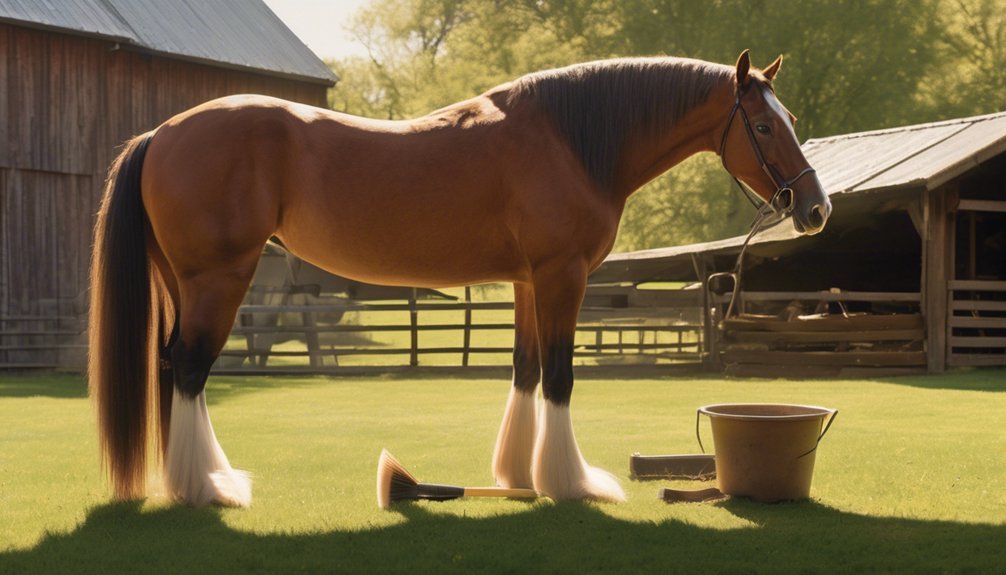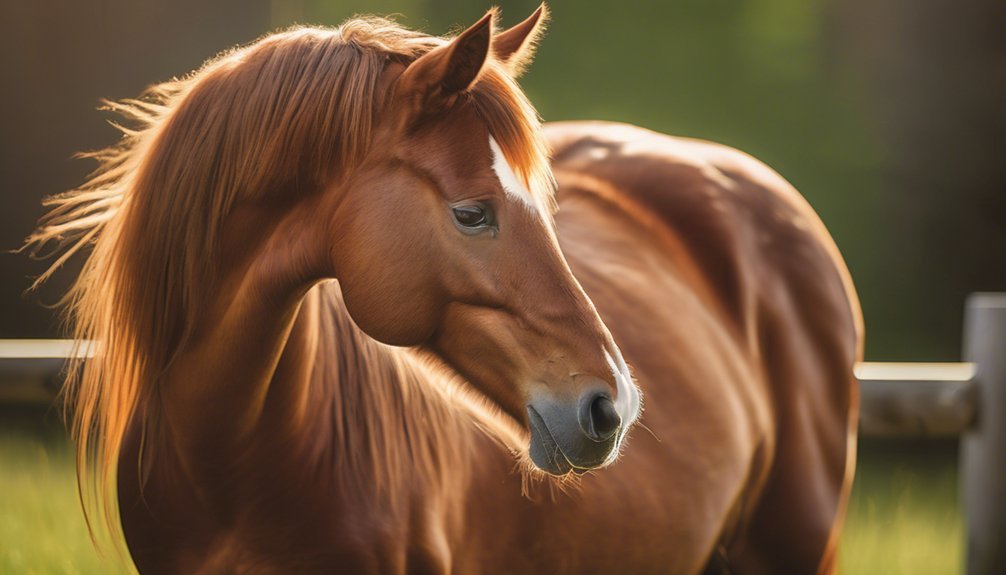
Dealing with horse coat shedding can be challenging, but understanding the process and applying effective strategies can make a significant difference. Regular grooming is essential, as it not only helps manage loose hair but also promotes skin health. Additionally, proper nutrition plays a crucial role in maintaining a shiny, healthy coat. As you navigate this seasonal change, consider how your horse's environment can impact their comfort and overall well-being.
Key Takeaways
- Establish a regular grooming schedule to remove loose hair and monitor skin health during the shedding process.
- Use quality grooming tools like shedding blades and curry combs to effectively manage shedding.
- Provide a balanced diet rich in omega-3 fatty acids, biotin, and zinc to support healthy coat growth.
- Maintain a comfortable environment with good ventilation and shaded areas to reduce stress during shedding.
- Consider using horse blankets during cooler temperatures to ensure comfort while shedding occurs.
Understanding the Shedding Process

As spring approaches and temperatures rise, horses naturally begin to shed their winter coats, a process that's essential for their health and comfort.
This shedding cycle, prompted by changes in daylight and temperature, helps maintain optimal coat health. You'll notice that your horse's thick winter fur transitions to a lighter, more breathable layer, allowing for better thermoregulation.
During this time, it's crucial to monitor your horse's skin condition, as the shedding process can sometimes lead to irritations or skin issues.
Providing proper nutrition and hydration can support healthy hair growth and skin.
Understanding this natural cycle not only fosters a closer bond with your horse but also ensures they remain comfortable and healthy during the seasonal transition.
Effective Grooming Techniques
Grooming your horse effectively during shedding season not only helps remove loose hair but also promotes healthy skin and coat.
To ensure a smooth grooming routine, follow these essential techniques:
- Choose the Right Grooming Tools: Invest in quality shedding blades, coarse curry combs, and soft brushes. Each serves a purpose in removing hair and stimulating the skin.
- Establish a Shedding Schedule: Regular grooming sessions—ideally every few days—keep loose hair in check and allow you to monitor your horse's skin condition.
- Be Gentle and Attentive: Pay attention to sensitive areas and adjust your pressure accordingly. This builds trust and makes the grooming experience enjoyable for both of you.
Nutritional Support for Healthy Coats

Maintaining a healthy coat during shedding season goes beyond just grooming; nutrition plays a key role in your horse's overall coat health. Providing a balanced diet rich in essential nutrients ensures that your horse's coat stays vibrant and healthy. Consider adding coat supplements to enhance nutrient balance, particularly those high in omega-3 fatty acids, biotin, and zinc.
| Nutrient | Benefits |
|---|---|
| Omega-3 Fatty Acids | Promotes shine and reduces inflammation |
| Biotin | Supports keratin production |
| Zinc | Aids in skin health and repair |
Managing the Shedding Environment
Creating a comfortable environment for your horse during shedding season can significantly reduce stress and promote a smoother coat transition.
By managing key environmental factors, you can help regulate shedding frequency and improve your horse's overall well-being. Here are three important aspects to consider:
- Temperature Control: Ensure your horse has access to shaded areas or cool shelters during warmer months to minimize discomfort.
- Ventilation: Maintain good airflow in their living space to prevent dust buildup, which can irritate their skin and exacerbate shedding.
- Cleanliness: Regularly clean stalls and living areas to reduce allergens and irritants that may affect your horse's coat health.
Tips for Maintaining Horse Comfort During Shedding

As the shedding season approaches, prioritizing your horse's comfort becomes increasingly important. To help with this, invest in quality shedding tools like curry combs and shedding blades. Regular grooming not only removes loose hair but also stimulates skin health.
Pay attention to your horse's coat condition; a well-groomed coat can prevent irritation during shedding.
Consider using horse blankets during the cooler mornings or evenings to keep your horse comfortable as they shed. These blankets can provide warmth while protecting against drafts.
Ensure your horse has access to fresh water and a balanced diet, as hydration and nutrition play a vital role in coat health.
Frequently Asked Questions
How Often Do Horses Shed Their Coats Each Year?
Horses typically shed their coats twice a year, following seasonal patterns. During spring and fall, you'll notice shedding cycles as they adapt to temperature changes. Understanding this helps you better support your horse's well-being throughout the year.
Can Stress Affect a Horse's Shedding Process?
Just like a storm can disrupt a calm sea, stress factors can significantly impact your horse's shedding triggers. Understanding this connection allows you to support your horse through challenging times, ensuring a healthier coat transition.
What Signs Indicate Excessive Shedding in Horses?
When you notice excessive shedding signs like patchy fur, skin irritation, or changes in coat health, it's essential to monitor your horse closely. These indicators could signal underlying health issues that need attention.
Are Some Horse Breeds More Prone to Shedding?
Some horse breeds, like the Thoroughbred, reveal shedding patterns more dramatically due to their breed characteristics. Understanding these nuances helps you appreciate their beauty, making the seasonal transition feel more like a natural, emotional journey.
When Should I Consult a Veterinarian About Shedding Issues?
If you notice unusual shedding patterns or your horse shows signs of health concerns, like skin irritation or excessive hair loss, it's best to consult a veterinarian. They can help ensure your horse stays healthy and comfortable.
Conclusion
In conclusion, effectively managing your horse's coat shedding involves a combination of grooming, nutrition, and environmental care. Did you know that horses can shed up to 30% of their winter coat in just a few weeks? By regularly grooming with quality tools and providing a balanced diet rich in omega-3 fatty acids, you can support a healthy coat and minimize discomfort. Creating a comfortable environment will further aid your horse during this seasonal transition, ensuring they feel their best.





